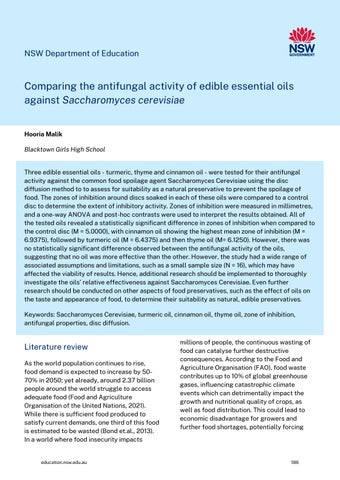NSW Department of Education
Comparing the antifungal activity of edible essential oils against Saccharomyces cerevisiae Hooria Malik Blacktown Girls High School Three edible essential oils - turmeric, thyme and cinnamon oil - were tested for their antifungal activity against the common food spoilage agent Saccharomyces Cerevisiae using the disc diffusion method to to assess for suitability as a natural preservative to prevent the spoilage of food. The zones of inhibition around discs soaked in each of these oils were compared to a control disc to determine the extent of inhibitory activity. Zones of inhibition were measured in millimetres, and a one-way ANOVA and post-hoc contrasts were used to interpret the results obtained. All of the tested oils revealed a statistically significant difference in zones of inhibition when compared to the control disc (M = 5.0000), with cinnamon oil showing the highest mean zone of inhibition (M = 6.9375), followed by turmeric oil (M = 6.4375) and then thyme oil (M= 6.1250). However, there was no statistically significant difference observed between the antifungal activity of the oils, suggesting that no oil was more effective than the other. However, the study had a wide range of associated assumptions and limitations, such as a small sample size (N = 16), which may have affected the viability of results. Hence, additional research should be implemented to thoroughly investigate the oils’ relative effectiveness against Saccharomyces Cerevisiae. Even further research should be conducted on other aspects of food preservatives, such as the effect of oils on the taste and appearance of food, to determine their suitability as natural, edible preservatives. Keywords: Saccharomyces Cerevisiae, turmeric oil, cinnamon oil, thyme oil, zone of inhibition, antifungal properties, disc diffusion.
Literature review As the world population continues to rise, food demand is expected to increase by 5070% in 2050; yet already, around 2.37 billion people around the world struggle to access adequate food (Food and Agriculture Organisation of the United Nations, 2021). While there is sufficient food produced to satisfy current demands, one third of this food is estimated to be wasted (Bond et.al., 2013). In a world where food insecurity impacts
education.nsw.edu.au
millions of people, the continuous wasting of food can catalyse further destructive consequences. According to the Food and Agriculture Organisation (FAO), food waste contributes up to 10% of global greenhouse gases, influencing catastrophic climate events which can detrimentally impact the growth and nutritional quality of crops, as well as food distribution. This could lead to economic disadvantage for growers and further food shortages, potentially forcing
186













